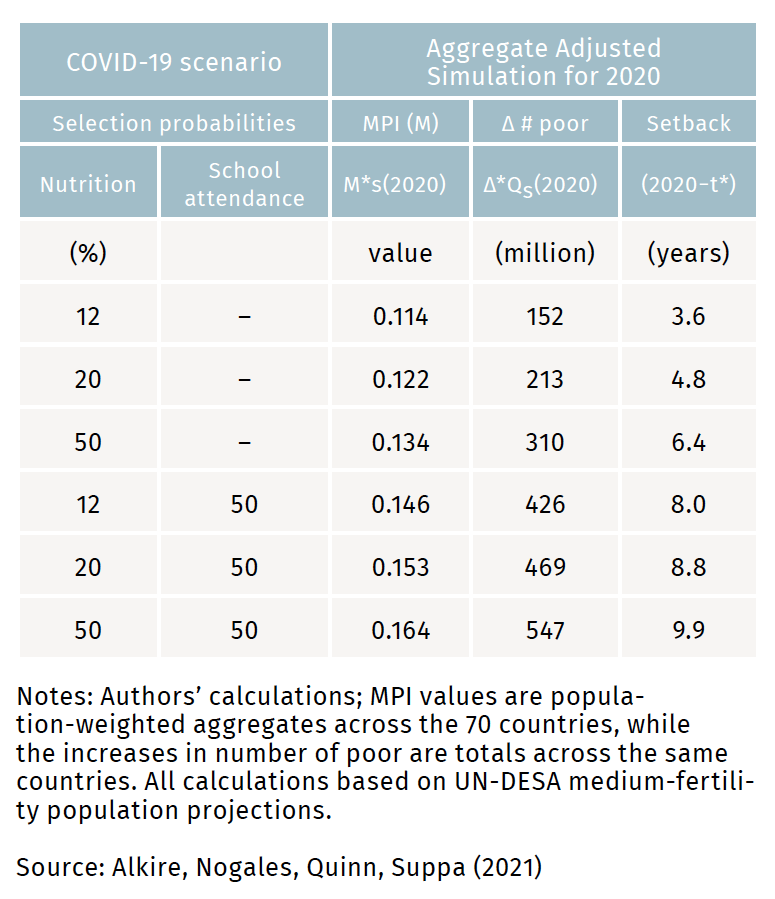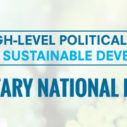
Search
Simulations and multidimensional poverty: reflections on a COVID-19 evaluation study

The current COVID-19 pandemic, which took hold in early 2020, put policymakers in a vexing situation. First, there is a high degree of uncertainty associated with both the effectiveness and potential side-effects of most policy measures aiming to curtail the spread of the virus, including the virus’ precise epidemiological characteristics. Secondly, much is at stake, including a significant number of premature deaths, extraordinary economic contractions, and the education of several young generations.
Meanwhile, policy-oriented research encounters a data scarcity, impeding grounded recommendations and advice as conventional impact evaluations are not yet feasible. Notwithstanding, situations like these require decisions even under such adverse circumstances.
In a recent study, we apply simulation techniques for a forecasted assessment of the pandemic and related policy responses on global multidimensional poverty. In this article we provide a non-technical discussion of this paper, highlighting both the usefulness and challenges of simulations for multidimensional poverty analyses.
Data and scenarios
In our study, we use micro datasets for 70 countries of the 2020 global Multidimensional Poverty Index (MPI) release and related changes over time, which is carefully documented in OPHI Methodological notes 49 and 501. The global MPI builds on 10 indicators organized in three dimensions (health, education, and living standards) and relies on the dual cutoff counting approach, sometimes called the Alkire-Foster method. While being estimated since 2010, the global MPI was revised in 2018 to better align with the Sustainable Development Goals. The global MPI is estimated based on comprehensive household survey datasets, such as the Demographic Health Survey (DHS) and the Multiple Indicator Cluster Survey (MICS).
In our simulations we implement scenarios for two indicators, deprivation in nutrition and school attendance because (i) they capture relevant short term effects, (ii) there is enough reliable information to inform how they can be affected by the pandemic, and (iii) they have a large weight in the global MPI.
Methodologically, simulations emerge as one promising tool to better understand multidimensional poverty.
Nutrition deprivation scenarios are informed by World Food Programme (WFP) data on food security risks. The WFP provides pre-pandemic numbers of food-insecure people in many countries.
We assume that food insecurity materialises in actual malnutrition among the poor and vulnerable people who have managed to avoid nutrition deprivations before the pandemic. Accounting for specific features of WFP data, we derive three plausible risk rates of increased nutrition deprivations: 12%, 20% and 50%.
Risks of school nonattendance are informed by UNESCO data on daily school closures around the world. We derive a risk of 50% for children in school age to experience significant loss of schooling, and thus deprivation in school attendance due to school closures during the first year of the pandemic.
Translation model and results
In early 2020, even many of the most recent country-level micro datasets were collected several years before the pandemic. As a consequence, taking simulation results at face value would be misleading, as countries’ recent poverty reductions would be ignored. Moreover, the simulated shocks themselves would not reflect 2020 conditions (2).
For this reason, we first nowcast multidimensional poverty to 2020, and then develop and apply a model which translates the simulated shocks to 2020, allowing us to compute potential increases in different outcomes due to the shocks. Table 1 shows, for instance, that according to our upper-bound scenario, the global MPI would increase to 0.164, whereas the number of poor people would increase by 547 million, which is considerable.
Additionally, we also compute the setback in terms of poverty reduction. We find that, depending on the underlying scenario, the pandemic may result in up to an entire decade of global multidimensional poverty reduction becoming undone.
Discussion
One implication we emphasize in the paper is that appropriate policy measures are needed to prevent these new deprivations from becoming entrenched. Previous research documents several measures to attenuate the effect of temporary school closures on school dropout rates (World Bank, 2020).
Methodologically, simulations emerge as one promising tool to better understand multidimensional poverty. First, simulations may be applied even when key information on certain aspects is unavailable. Moreover, if correctly devised, simulations may implicitly account for various aspects of the micro data, including the joint distribution of deprivations (e.g. of specific deprivation profiles) and various socio-demographic aspects (e.g. age structure of the population).
Simulations, however, also pose important challenges. First, outdated micro data may not accurately reflect the current situation in a particular country and thus support misleading conclusions. A translation model, as proposed in our paper, may address this issue in some instances, but simply having more recent micro data at hand may suffice.
Another shortcoming of simulations is that their plausibility and accuracy are not easy to assess. Therefore, a very clear and detailed documentation of the underlying assumptions and the data used to inform the different scenarios is vital for a transparent analysis. Otherwise, a simulation study is inevitably tainted by an unacceptable degree of arbitrariness.
A third challenge is related to the actual implementation of the scenarios: Which individuals or households are selected to experience a new deprivation? How exactly is this implemented, and why is it justified? In our schooling scenario, for instance, we implement a uniform risk for all school age children. This is supported by an unprecedentedly widespread school closure around the globe. Other exercises, such as the simulation of a specific policy measure, undeniably require much more elaborated and fine-tuned implementations to obtain truly informative results.
The full potential of simulation techniques for analysing multidimensional poverty is certainly not yet fully developed. Addressing these and other challenges first would clearly be the next step forward.
Suppa gratefully acknowledges funding of the “la Caixa” foundation (LCF/PR/SR20/52550004).
(1) More precisely we rely on 70 countries for arriving at the results reported at the global level, whereas we make use of 97 countries during the simulation exercise itself.
(2) Indeed, our analysis suggests a non-linear relationship between level of multidimensional poverty and the simulated shock.
This article was published in Dimensions 13

















